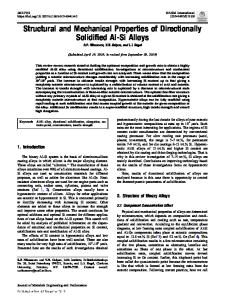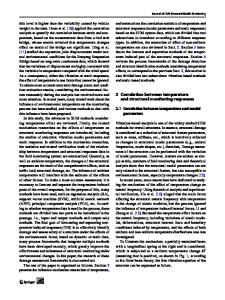Structural Evolution and Micromechanical Properties of Ternary Ni-Fe-Ti Alloy Solidified Under Microgravity Condition
- PDF / 3,594,040 Bytes
- 12 Pages / 593.972 x 792 pts Page_size
- 92 Downloads / 262 Views
CTION
CONTAINERLESS and microgravity conditions affect the nucleation and heat transfer in alloys during solidification, and peculiar phenomena, such as a refinement of the microstructure, and reduction in segregation and solute trapping were discovered, which effectively improves the microstructure as well as the mechanical properties of alloys.[1–7] Recent studies have shown that under the conditions of high undercooling and rapid solidification, the microhardness of an alloy is improved significantly with an increase in the undercooling.[8–10] Methods, such as containerless drop tube processing, combine the characteristics of high undercooling and rapid cooling rate. Therefore, it is suitable to study the microstructure evolution and hardening mechanisms of substantially undercooled alloys by using drop tube technology.[4,10–16] Chen et al.[16] studied the microstructure evolution of impulse atomized Al-Fe droplets and verified metastable AlxFe (x = 4.0 to 4.4) in the eutectic structure by neutron diffraction analysis.
XINGWU LI, YING RUAN, and BINGBO WEI are with the Department of Applied Physics, Northwestern Polytechnical University, Xi’an, 710072, Shaanxi, China. Contact e-mail: [email protected] Manuscript submitted December 3, 2019.
METALLURGICAL AND MATERIALS TRANSACTIONS A
Oloyede et al.[8] investigated the commercial gray cast iron using a 6.5 m high vacuum drop tube and found that the microhardness increases with both the increasing cooling rate and undercooling. The influence of the undercooling on dynamic crystal growth and rapid dendrite growth and their impact on the micromechanical properties is worthy of clarification. Ni-Fe-based alloys are complex metallic alloys that are used in many different materials such as steels, Ni-based superalloys, shape memory alloys, and amorphous materials.[17–21] Because of their excellent corrosion resistance and high strength, Ni-Fe-Ti alloys have been studied extensively. The phase equilibrium and thermodynamic characteristics of the Ni-Fe-Ti system was reviewed by Gupta et al,[22,23] in which the liquidus projection as well as two isothermal sections at 900 °C and 1000 °C were established. Later, the liquidus projection in the Ti-lean region was modified because of two ternary eutectic transformations at 1108 °C and 1099 °C according to the research of Duarte et al.[24] Additionally, their data also indicated that the solid solubility of Ti in c-(Fe,Ni) varies depending on the Ni/ Fe ratio and decreases with decreasing temperature. In terms of performance and applications, FeNi alloys exhibit excellent soft magnetic properties such as low coercivity and high saturation magnetization. They are widely applied in communication and control systems.[25,26] Intermetallic compounds of FeTi and Ti2Ni with high hydrogen absorption make the Ni-Fe-Ti
system also available as hydrogen storage materials.[27] However, investigations on the rapid solidification mechanism and mechanical properties of Ni-Fe-Ti alloys solidified with a high undercooling are still limited. The mechanical
Data Loading...











